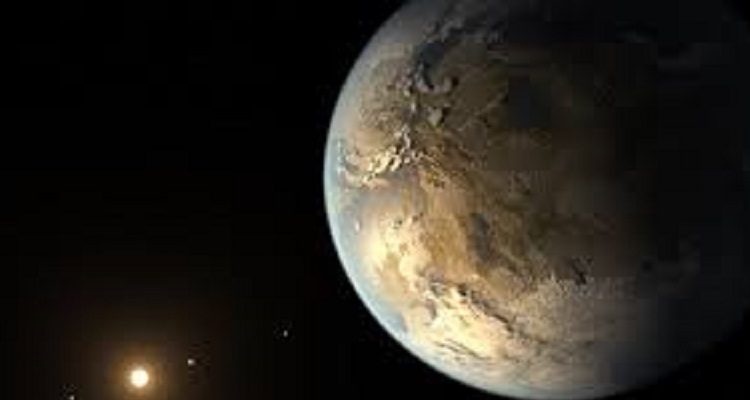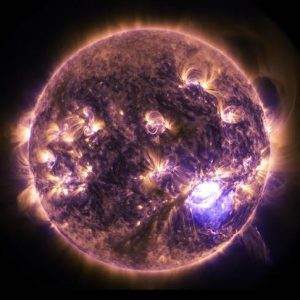New Planet Discovered by NASA
NASA Discovers another Planet that’s 100-light years Away
The National Aeronautics and Space Administration’s (NASA) Transiting Exoplanet Survey Satellite (TESS) programme discovered fresh findings once more. In the “TOI 700” system, which is only 100 light-years from Earth, they found a second Earth-like star. The planet “TOI 700 e” is the second planet in this star system to circle in the habitable zone after “TOI 700 d.” According to several reports from international media, NASA “Jet Propulsion Laboratory” (JPL) astronomer Emily Gilbert (Emily Gilbert), who oversaw the TESS project, declared during the 241st meeting of the American Astronomical Society in Seattle that they were barely 100 metres from the ground. Another Earth-sized planet, TOI 700 e, was discovered circling in the habitable zone of the Doradus dwarf system, which is 100 light-years wide.
Only 100 light-years away from Earth, NASA has found another planet the size of Earth called “TOI 700 e” in the star system “TOI 700”. After “TOI 700 d,” this is the second planet in the star system that orbits a planet in the habitable zone. The National Aeronautics and Space Administration’s (NASA) Transiting Exoplanet Survey Satellite (TESS) programme discovered fresh findings once more. The second planet in this star system after “TOI 700 d” that orbits in the habitable zone is dubbed “TOI 700 e,” and it is Earth-sized. According to several reports from international media, NASA “Jet Propulsion Laboratory” (JPL) astronomer Emily Gilbert (Emily Gilbert), who oversaw the TESS project, declared during the 241st meeting of the American Astronomical Society in Seattle that they were barely 100 metres from the ground. Another Earth-sized planet, TOI 700 e, was discovered circling in the habitable zone of the Doradus dwarf system, which is 100 light-years wide. NASA discovers earth-like planet TOI 700 e.
Source: Pexels.com
In the “TOI 700” system, TESS found in 2020 that planets TOI 700 b, c, and d orbited it from the inside out, with “TOI 700 d” located in the region referred to as the habitable zone, where liquid water may flow. It is currently known that a planet named “TOI 700 e” has been found in this system’s habitable zone. “The future of the TOI 700 system is interesting,” Gilbert said. “This is one of the rare systems we are aware of that includes many tiny planets in habitable zones.” The new planet “TOI 700 e” is about 10% smaller than the planet “TOI 700 d,” demonstrating yet again how TESS observations are assisting in the discovery of ever-smaller planets. NASA discovers earth-like planet TOI 700 e. “TOI 700 d” completes one revolution every 37 Earth days, but the planets are tidally reliant, which means that one side always confronts the star and the other part always faces the opposite direction of the star.
The recently found “TOI 700 e,” which orbits its star in 28 days and is located between c and d, may likewise be tidally dependent. Gilbert stated that more investigation into the TOI 700 system is being conducted utilising both space-based and terrestrial observatories to find out more about this unique system. The Transiting Exoplanet Survey Satellite of NASA does outstanding job. Imagine telling someone in the future, 1,000 years from now, that scientists would develop a device that will find extraterrestrial worlds orbiting at distances beyond human comprehension. NASA discovers earth-like planet TOI 700 e.
That’s TESS.
This spacecraft’s equipment has discovered hundreds of exoplanets since 2018. We have eyeballs in a rugby ball-shaped one, a spherical with crystals falling from the edges of it, and another that seems to be covered in oceans of lava. The elixir of life, water, may cover one of those weird regions dutifully pursued by TESS, according to a report released on Wednesday by worldwide experts. I don’t know about you, but I keep having visions of the Interstellar moment where Cooper landed on a planet with waves the size of buildings. According to the team’s analysis, which was just published this month in the Astronomical Journal, this potential “ocean world” is located around 100 light-years from Earth and revolves around a binary star system in the constellation Draco. NASA discovers earth-like planet TOI 700 e. It is known as TOI-1452 b, and scientists estimate that it is 70% bigger than Earth, nearly five times as massive, spins once every seven Earth days, and is neither too hot or cold enough for liquid water to be present on its surface.
If the theory that TOI-1452 b may appear in Poseidon’s dreams is accurate, it would resemble several locations in our own solar system. Enceladus, Saturn’s icy and brilliant moon, is supposed to be home to a vast ocean of underground saltwater. Additionally, the biggest moon in our solar system, Ganymede, one of Jupiter’s brilliant allies, has a significant area of frozen water of its own.
Sounds like a job for the Webb Space Telescope
However, the difficulty is that its density appears to be consistent with an extraordinarily deep ocean; alternatively, NASA reports, it might be a massive rock with little to no atmosphere or even an atmosphere made of hydrogen and helium. Charles Cadieux, a graduate student at the University of Montreal and a representative of the university’s Institute for Exoplanet Research, served as the study’s primary author and stated in a press release on Wednesday that TOI-1452 b is one of the top candidates for an oceanic planet that we have discovered thus far. The planet’s mass and radius point to a far lower density than would be predicted for one made primarily of rock and metal, like Earth. NASA discovers earth-like planet TOI 700 e.
Exoplanet discoveries have increased recently, yet there is still a lot of enthusiasm when one is made nowadays. This is so that we may decode the wonders of the cosmos, including cosmic data disguised as infrared light, using the James Webb Space Telescope, an extraordinary device located a million miles from Earth. And thankfully, it’s in a part of the sky that the telescope can view all year round, according to the TOI-1452 b news release. The most recent study’s author René Doyon, director of iREx at the University of Montreal, and a fellow of one of the top JWST teams, indicated that observations with the Webb telescope would be crucial to understanding TOI-1452 b. NASA discovers earth-like planet TOI 700 e. He said in the declaration. “We shall take some time at Webb’s property as soon as we can to examine this unusual and lovely world,” said Webb.
Doyon and other researchers want to use JWST to examine this exoplanet’s atmosphere more closely to see whether it really is a world with liquid water. It is one of the only temperate-climate worlds known to display characteristics similar to those of an oceanic planet, according to the study. It’s so tempting to consider it because of this. Additionally, the fact that the star TOI-1452 b revolves in the binary system is close to the planet of interest and considerably smaller than our Sun explains why TOI-1452 b has such a chilly environment. According to the study’s authors, this gas ball is located around 2.5 times further from its star companion than the Sun is from Pluto. NASA discovers earth-like planet TOI 700 e.
Intriguingly, the scenario as a whole was so complicated that TESS need help in order to compose the TOI-1452 b tale. Researchers had to use some additional cutting-edge tools, such the PESTO camera from the Observatoire du Mont-Megantic, which would also startle our fictitious ancient audience. This gadget specialises in the electromagnetic spectrum’s red region. The WMO was essential in determining the nature of the signal and determining the planet’s radius, according to Cadieux. “The exam wasn’t routine. NASA discovers earth-like planet TOI 700 e. We had to confirm that the TESS signal was indeed coming from an exoplanet circling TOI-1452, the bigger of the two stars in this binary star system.
The 1990s were an inspiring decade. It coincided with the introduction of the original Sony PlayStation, the nationwide rollout of Tickle Me Elmo, and the beginning of Google’s illustrious empire. More precisely, in 1992, something truly extraordinary occurred. The first planet discovered by scientists outside of our solar system opens up a brand-new field of space exploration: the look for extraterrestrial planets. Experts have been able to catalogue hundreds of exoplanets since that joyful discovery, serving as harsh reminders of how fragile the eight spheres that make up our cosmic corner are. These are places of unusual, unbreakable ice cliffs, horrific lava lakes, and jewel showers. NASA discovers earth-like planet TOI 700 e. There are even a few Earth-like planets in parallel realities that may have extraterrestrial life.
And on Thursday, a team of exoplanet explorers revealed in Nature Astronomy journal that we had once again added to our collection of extraterrestrial worlds. The elixir of life, water, seems to surround two exoplanets that have been discovered by scientists using NASA’s Hubble and Spitzer orbital space telescopes. These blue objects, known as Kepler-138 c and Kepler-138 d, orbit a dim red dwarf star in a system 218 light-years away. NASA discovers earth-like planet TOI 700 e. They have almost twice the mass of Earth and are around 1.5 times as big as our globe. The myth of the Kepler couple is somewhat perplexing in light of these data, which debunk the notion that they are some sort of Earthly relatives.
Björn Benneke, a professor at the University of Montréal and co-author of the research, stated that “we used to assume that planets somewhat larger than Earth were gigantic spheres of metal and rock, like enlarged copies of Earth, and that’s why we called them super-Earths.” In reality, Kepler d is still referred to be a “possibly rocky” world in NASA’s online exoplanet database, for instance.
About the Author
Ahsan Azam is the author who specializes in avionics as well as research writing. The author has a keen attention to detail and is focused on providing interesting content to the readers.
About Stone Age Technologies SIA
Stone Age Technologies SIA is a reliable IT service provider, specializing in the IT Solutions. We offer a full range of services to suit your needs and budget, including IT support, IT consultancy, remote staffing services, web and software development as well as IT outsourcing. Our team of highly trained professionals assist businesses in delivering the best in IT Solutions. Contact us for your IT needs. We are at your service 24/7.










Write a Comment